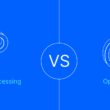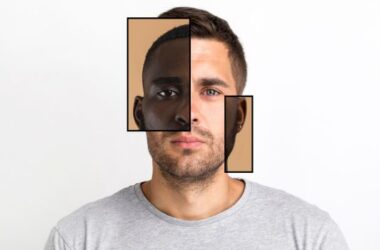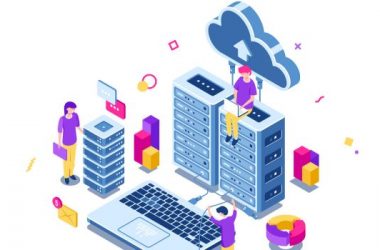Have you ever wondered if your phone could simply understand what you’re doing by sensing your movements? If not, we introduce you to the technology of human activity recognition, a rapidly growing field in computer science that interprets and analyzes human actions.
HAR recognizes more than just basic movements like walking or running. It delves deeper, aiming to identify a wide range of activities we perform in our daily lives. It allows our devices to understand our activity patterns. For instance, phone brightness might adjust based on walking or running (detected by accelerometers) to prevent battery drain, or lights automatically turn on when you enter a room (detected by motion sensors).
To comprehend the basics of human activity recognition, we will explore its key concepts, advancements, challenges, and prospects in this blog.
Key Concepts of Human Activity Recognition
Human activity recognition (HAR) is the process of interpreting human motion using computer and machine vision technology. It learns and interprets human activities, gestures, or behaviors recorded by sensors, translating the movement data into action commands for computers to execute and analyze.
HAR technology aims to automate the prediction and analysis of human behavior. This benefits various fields, including sports training, security, entertainment, ambient-assisted living, and health monitoring and management.
Most specifically, human pose estimation has gained popularity due to its usefulness and versatility. Estimating Reliable posture labels helps hospital environments better monitor patients. HAR goes beyond simply recognizing basic movements; it aims to decipher a wide range of daily activities, playing an essential role in understanding human behavior patterns.
The Inner Workings of HAR Systems
Human activity recognition (HAR) is a field of study that aims to identify a person’s specific movements or actions based on sensor data that is often performed indoors. Here’s a breakdown of the key steps.

- Data Collection: The first step involves gathering information about human activity. This can be done through various sensors.
- Wearable sensors: Accelerometers, gyroscopes, and magnetometers embedded in smartwatches or fitness trackers capture data on body movements, acceleration, and orientation.
- Camera-based systems: Cameras can capture video footage, which is then analyzed to recognize body movements and posture.
- Preprocessing: Raw sensor data often needs cleaning and preparation before being used for analysis. This may involve removing noise, filtering irrelevant data, or formatting the data for compatibility with machine learning algorithms.
- Model Deployment: The heart of HAR lies in its machine-learning models. These models are trained on a vast amount of labeled data, where each data point represents a specific activity (e.g., walking, sitting, jumping). Through the training process, the model learns to identify patterns in the data and categorize new, unseen activities.
Human Activity Recognition Models
When we explore the field of human activity recognition (HAR) further, it becomes essential to comprehend the models that help us interpret complex behavior patterns. HAR models are necessary for evaluating sensor and wearable data and deriving actionable insights into human behavior. Two of them are.
- RNNs, or Recurrent Neural Networks: Recurrent Neural Networks (RNNs) are a key component of human activity recognition (HAR) systems because they are exceptional at identifying temporal relationships within sequential data.This quality is beneficial when handling time-consuming tasks. RNNs are excellent at deciphering movement patterns, which enables a dynamic and nuanced interpretation of human behaviors.By retaining a memory of previously learned information, RNNs can comprehend sequences nuancedly. Thanks to this memory mechanism, the human action model can recognize complex patterns in sequential sensor data by considering each data point’s context about its temporal neighbors.
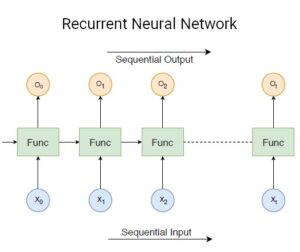
- CNNs, or Convolutional Neural Networks: By interpreting sensor data as temporal images, convolutional neural networks (CNNs), which are well-known for their efficacy in image-related tasks, find application in HAR. This novel method allows CNNs to identify spatial correlations in the data, offering a reliable way to identify complex human actions.CNNs use their ability to identify spatial relationships by processing sensor input as temporal pictures. This is especially helpful in HAR, where the way sensor data is arranged spatially plays a major role in helping to interpret complex operations. CNNs enhance the correct interpretation and classification of human activities by the human action model.
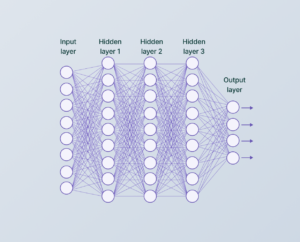
Human Activity Recognition Datasets
The quality and variety of training and assessment datasets directly impact the performance of human action recognition models. In addition to accurately reflecting the complexity of real-world circumstances, a carefully chosen action recognition dataset guarantees that the HAR models produced can be used for a wide range of tasks and settings.
- UCI-HAR Dataset: One of the mainstays of the HAR community is the UCI-HAR Dataset, which is widely used as a standard to measure human action model performance. This action recognition dataset contains various activities recorded using accelerometers and gyroscope sensors, such as walking, running, and cycling. Academics and practitioners need to comprehend the distinctive features of the UCI-HAR Dataset, such as its diverse activity set and well-defined labels if they want to compare their models to industry standards.
- WISDM DatasetIn real-world circumstances, the Wireless Sensor Data Mining (WISDM) dataset provides insights into the opportunities and difficulties associated with HAR. The WISDM action recognition dataset, which consists of accelerometer data gathered from cellphones, offers a wealth of information for comprehending everyday human activity. Examining the WISDM Dataset illuminates its uses and advances HAR research, especially when smartphone-based sensors are essential. Understanding its distinctive qualities gives academics and practitioners new perspectives for creating models that may be used in a wider range of user scenarios.
- Benchmarking and GeneralizationThe effectiveness and generalizability of HAR models are assessed by benchmarking against well-known datasets such as WISDM, Opportunity, and UCI-HAR. These datasets provide a wide range of activities, including regular and irregular acts, so models trained on them can be flexible enough to be used in different situations. By carefully examining these datasets, researchers and practitioners can learn a great deal about their models’ advantages and disadvantages, which opens the door to further development and progress in the field of human activity recognition.
Practical Applications of Human Activity Recognition Technology
HAR technology has a wide range of potential uses and impacts many different industries. Here are a few real-life examples of how HAR is having an impact.
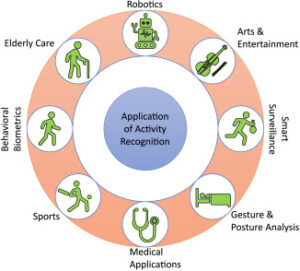
-
Healthcare
Monitoring the daily activities of elderly patients or individuals with disabilities helps caregivers track their health status and provide necessary assistance. It also detects falls, which is crucial for the safety of elderly individuals living alone.
-
Sports Performance Analysis
Athletes wear smartwatches and other wearable devices that use HAR technology to track their movement and performance during training or competitions. This data can be analyzed to provide insights into improving their performance.
-
Smart Homes and Buildings
With HAR technology, houses, and commercial buildings can adjust lighting, temperature, and other factors based on the occupant’s activities. This reduces energy consumption while providing a more comfortable living or working environment.
-
Security and Surveillance
HAR models can be trained to recognize suspicious or criminal activities, making them valuable in security and surveillance systems. This technology helps to detect unusual patterns in behavior, alerting authorities to potential threats.
-
Transportation
HAR is used in autonomous vehicles and public transportation to monitor driver behavior and ensure the safety of passengers. It can also detect drowsy or distracted driving, preventing accidents and saving lives.
-
Virtual Reality and Gaming
HAR is used in virtual reality and gaming to enhance the user experience by accurately tracking body movements and replicating them in a virtual environment. This allows for more immersive gameplay and training simulations.
Advancements in Human Activity Recognition
-
Context-aware recognition
Traditional HAR systems mainly concentrate on identifying activities themselves. However, advancements in integrating context awareness mean the system can consider factors like time of day, location, and weather conditions to enhance activity recognition accuracy.
For example, if the system detects rapid, repetitive motions in the morning near the kitchen, it may interpret it as “preparing breakfast” rather than “doing push-ups” typically associated with a gym environment.
-
Transfer Learning and Personalization
Deep learning models usually need lots of labeled data to train. With advancements in transfer learning, researchers can use pre-trained models on general activity datasets and adjust them for specific uses. This cuts down on training time and enables personalization. For instance, a user’s activity data can refine the model’s accuracy for their particular movement patterns.
-
Explainable AI for HAR
Deep learning models can sometimes seem like black boxes, making it unclear how they make decisions. This can pose challenges, especially in safety-critical applications like fall detection in HAR. Researchers are now exploring Explainable AI (XAI) to address this issue. XAI aims to make these models more transparent, helping us understand how they classify activities.
-
Activity Recognition in Unconstrained Environments
Traditionally, HAR research focused on controlled settings like labs or homes. Now, advancements are happening in recognizing activities in complex environments. This involves handling factors like sensor noise and different body types. Imagine a system accurately tracking your workout outdoors or recognizing your activity patterns while grocery shopping in crowds.
Addressing Challenges in Human Activity Recognition
Even with the improvements, there are still several concerns with HAR, such as data accuracy, privacy issues, and the need for real-time processing.
Because human movement patterns fluctuate and sensors have limits, data accuracy in HAR is a substantial difficulty. The solution to this problem is to create increasingly complex algorithms that can analyze data, learn from it, and adjust to variations in human movement patterns. Some of these algorithms are listed here.
Challenge 1 – Data Accuracy
Sensor limitations and variability in human movement can impact data accuracy. A sweaty sensor during a workout or someone walking with a limp can confuse the system.
Solution
- Data Augmentation: Artificial intelligence techniques can improve the model’s resistance to noise and unforeseen movements by simulating real-world situations and creating synthetic sensor data with variations.
- Sensor Fusion: Comparing data from several sensors (accelerometer, gyroscope, magnetometer) may boost accuracy by giving a more comprehensive picture of movement than just using one.
Challenge 2 – Real-Time Processing
Some applications, like fall detection, require immediate activity recognition. However, processing complex sensor data in real time can be computationally expensive, especially for wearables with limited resources.
Solution
- Lightweight Models: Scientists are developing effective deep-learning models tailored for wearables. These models allow real-time activity recognition on devices with limited resources and require less processing power.
- Edge Computing: By processing some of the wearable’s data, processing delays can be minimized by lowering the volume of data that must be transferred to the cloud for analysis.
Challenge 3: Privacy Concerns
HAR technology collects data on our movements and activities, raising privacy concerns. Users might be hesitant to wear devices that track their every step.
Solution
- Federated Learning: Users can train models locally on their devices without sending their data to a central server. This method ensures that user data remains private while benefiting from enhanced performance by sharing model changes.
- Differential Privacy: Accurate model training is still possible, but individual identification becomes challenging due to the noise introduced into the data before processing.
Challenge 4 – Limited Generalizability
HAR models often struggle with generalizability. A model trained on data from young adults might not perform well when used for elderly individuals or those with physical limitations.
Solution
- Domain Adaptation Techniques: Scholars are currently researching methods to adapt the HAR model to different user populations and environmental conditions. Transfer learning is a strategy that can be employed to customize a model, originally trained on a general dataset, for specific user groups or environments.
- Data Collection from Diverse Populations: To create models that better reflect real-world situations, it is crucial to develop datasets that encompass a wider variety of user characteristics, including age, body types, and activity levels.
Conclusion
Technological developments in Human Activity Recognition are rapidly approaching highly precise and individualized recognition systems. As researchers continue to push the boundaries of this technology, we can expect to see more real-world applications and improvements in accuracy, privacy, and efficiency in the near future.
HAR has already shown immense potential in healthcare, sports performance monitoring, and smart homes. With continued progress, we can expect to see even more exciting applications of this technology in our daily lives. So, next time you put on your fitness tracker or use a virtual assistant to control your home devices, remember that the power of HAR is working behind the scenes to make it all possible.

Dawood is a digital marketing pro and AI/ML enthusiast. His blogs on Folio3 AI are a blend of marketing and tech brilliance. Dawood’s knack for making AI engaging for users sets his content apart, offering a unique and insightful take on the dynamic intersection of marketing and cutting-edge technology.


